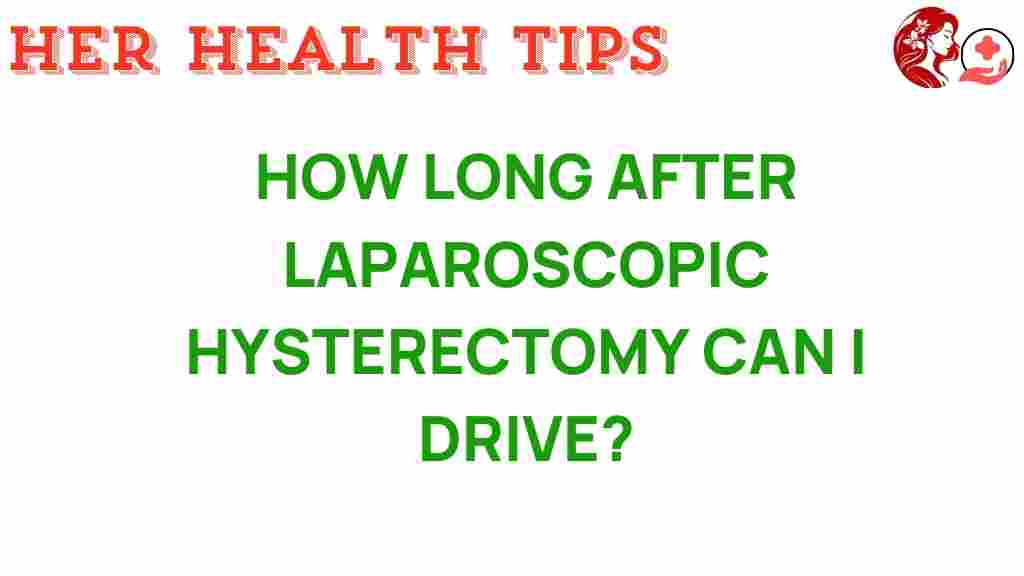Laparoscopic hysterectomy is a minimally invasive surgical procedure that allows for the removal of the uterus through small incisions. While this procedure is often preferred due to its shorter recovery time and reduced postoperative discomfort, many women find themselves wondering about their ability to resume normal activities, particularly driving, after the surgery. Understanding the recovery time and following appropriate safety guidelines is crucial for ensuring a smooth healing process.
Understanding Laparoscopic Hysterectomy
A laparoscopic hysterectomy involves the use of a laparoscope, a thin tube with a camera, allowing surgeons to remove the uterus with minimal disruption to surrounding tissues. This method is often associated with less pain, shorter hospital stays, and quicker recovery compared to traditional open surgery.
Postoperative Care and Recovery Time
After undergoing a laparoscopic hysterectomy, patients will experience a recovery period that varies from person to person. Generally, the recovery time can range from a few weeks to several months, depending on various factors such as:
- Individual health status
- Presence of any complications
- Adherence to postoperative care guidelines
Most women can expect to return to light activities within 1-2 weeks, while more strenuous activities and driving may take 4-6 weeks. It is essential to follow your doctor’s advice regarding your specific recovery timeline.
When Can You Safely Drive?
One of the common concerns after laparoscopic hysterectomy is when it is safe to resume driving. This decision depends on several factors, including:
- Pain Management: If you are still taking pain medications that can impair your ability to drive (such as narcotics), it is crucial to wait until you are off these medications.
- Physical Capability: You should be able to move comfortably and without significant pain to operate a vehicle safely.
- Doctor’s Recommendations: Always consult your doctor for personalized advice regarding when it is safe for you to start driving again.
As a general guideline, many doctors suggest that patients can resume driving about 2 weeks post-surgery, provided they feel comfortable and are no longer taking strong pain medications.
Step-by-Step Process for Resuming Driving
Here are steps to help you navigate the process of safely returning to driving after your laparoscopic hysterectomy:
- Assess Your Pain Level: Before considering driving, evaluate your pain level. You should be capable of sitting comfortably and turning your body without discomfort.
- Stop Pain Medications: Ensure that you are no longer using narcotics or any medications that could impair your reflexes.
- Test Your Reflexes: Practice moving your legs and arms to ensure that you can respond quickly and effectively.
- Short Trips First: Start with short trips around your neighborhood to gauge your comfort level and ability to drive.
- Listen to Your Body: If you experience pain or discomfort while driving, it is best to stop and consult your doctor.
Safety Guidelines for Driving After Surgery
Following safety guidelines is essential when resuming driving after a laparoscopic hysterectomy. Here are some recommendations:
- Wear Your Seatbelt: Always wear a seatbelt for safety.
- Avoid Long Distances: Initially, avoid long drives until you are fully comfortable and confident in your abilities.
- Avoid High-Impact Situations: Stay away from driving in heavy traffic or adverse weather conditions as you are still adjusting to your post-surgery state.
- Have a Backup Plan: Arrange for someone to drive you if you feel uncertain about your ability to drive safely.
Common Concerns and Troubleshooting Tips
Many women have questions and concerns about their recovery, particularly regarding driving. Here are some common issues and troubleshooting tips:
- Feeling Weak or Dizzy: If you feel weak or dizzy, it is advisable to wait longer before attempting to drive. These symptoms can be due to anesthesia effects or medication.
- Pain During Driving: If you experience pain while driving, consider using a cushion for added comfort and support.
- Difficulty with Seatbelts: If your incision site is sensitive, make adjustments to your seatbelt to avoid direct pressure on the area.
If you have ongoing concerns about your recovery time or driving capabilities, it’s essential to consult with your healthcare provider or surgeon for tailored advice.
Conclusion
Recovering from a laparoscopic hysterectomy is a significant process that requires attention to your body’s healing process and adherence to safety guidelines. The question of when you can safely drive is dependent upon your individual recovery timeline, pain management, and your doctor’s advice. By following the steps outlined above and paying close attention to your body’s signals, you can navigate your recovery while prioritizing your safety.
For more information on women’s health and postoperative care, consider exploring resources available through health organizations or consult your healthcare provider for personalized guidance.
This article is in the category Reproductive and created by HerHealthTips Team
